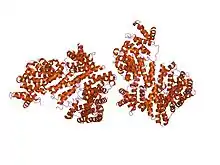CAS/CSE protein family
In molecular biology, the CAS/CSE protein family is a family of proteins which includes mammalian cellular apoptosis susceptibility (CAS) proteins and yeast chromosome-segregation protein, CSE1.[1] CAS is involved in both cellular apoptosis and proliferation.[2][3] Apoptosis is inhibited in CAS-depleted cells, while the expression of CAS correlates to the degree of cellular proliferation. Like CSE1, it is essential for the mitotic checkpoint in the cell cycle (CAS depletion blocks the cell in the G2 phase), and has been shown to be associated with the microtubule network and the mitotic spindle,[3] as is the protein MEK, which is thought to regulate the intracellular localization (predominantly nuclear vs. predominantly cytosolic) of CAS. In the nucleus, CAS acts as a nuclear transport factor in the importin pathway.[4] The importin pathway mediates the nuclear transport of several proteins that are necessary for mitosis and further progression. CAS is therefore thought to affect the cell cycle through its effect on the nuclear transport of these proteins.[5] Since apoptosis also requires the nuclear import of several proteins (such as P53 and transcription factors), it has been suggested that CAS also enables apoptosis by facilitating the nuclear import of at least a subset of these essential proteins.[6]
| CAS/CSE protein, C-terminus | |||||||||
|---|---|---|---|---|---|---|---|---|---|
 the exportin cse1 in its cargo-free, cytoplasmic state | |||||||||
| Identifiers | |||||||||
| Symbol | CAS_CSE1 | ||||||||
| Pfam | PF03378 | ||||||||
| InterPro | IPR005043 | ||||||||
| |||||||||
| Cse1 | |||||||||
|---|---|---|---|---|---|---|---|---|---|
 the exportin cse1 in its cargo-free, cytoplasmic state | |||||||||
| Identifiers | |||||||||
| Symbol | Cse1 | ||||||||
| Pfam | PF08506 | ||||||||
| Pfam clan | CL0020 | ||||||||
| InterPro | IPR013713 | ||||||||
| |||||||||
Members of the CAS/CSE family of proteins have two domains. An N-terminal Cse1 domain, which contains HEAT repeats, and a C-terminal domain.[7]
References
- Brinkmann U, Brinkmann E, Gallo M, Pastan I (October 1995). "Cloning and characterization of a cellular apoptosis susceptibility gene, the human homologue to the yeast chromosome segregation gene CSE1". Proc. Natl. Acad. Sci. U.S.A. 92 (22): 10427–31. Bibcode:1995PNAS...9210427B. doi:10.1073/pnas.92.22.10427. PMC 40810. PMID 7479798.
- Brinkmann U, Brinkmann E, Gallo M, Scherf U, Pastan I (May 1996). "Role of CAS, a human homologue to the yeast chromosome segregation gene CSE1, in toxin and tumor necrosis factor mediated apoptosis". Biochemistry. 35 (21): 6891–9. doi:10.1021/bi952829+. PMID 8639641.
- Scherf U, Pastan I, Willingham MC, Brinkmann U (April 1996). "The human CAS protein which is homologous to the CSE1 yeast chromosome segregation gene product is associated with microtubules and mitotic spindle". Proc. Natl. Acad. Sci. U.S.A. 93 (7): 2670–4. Bibcode:1996PNAS...93.2670S. doi:10.1073/pnas.93.7.2670. PMC 39688. PMID 8610099.
- Kutay U, Bischoff FR, Kostka S, Kraft R, Gorlich D (September 1997). "Export of importin alpha from the nucleus is mediated by a specific nuclear transport factor". Cell. 90 (6): 1061–71. doi:10.1016/S0092-8674(00)80372-4. PMID 9323134. S2CID 16092404.
- Kutay U, Bischoff FR, Kostka S, Kraft R, Görlich D (September 1997). "Export of importin alpha from the nucleus is mediated by a specific nuclear transport factor". Cell. 90 (6): 1061–71. doi:10.1016/S0092-8674(00)80372-4. PMID 9323134. S2CID 16092404.
- Brinkmann U (March 1998). "CAS, the human homologue of the yeast chromosome-segregation gene CSE1, in proliferation, apoptosis, and cancer". Am. J. Hum. Genet. 62 (3): 509–13. doi:10.1086/301773. PMC 1376967. PMID 9497270.
- Cook, A.; Fernandez, E.; Lindner, D.; Ebert, J.; Schlenstedt, G.; Conti, E. (2005). "The Structure of the Nuclear Export Receptor Cse1 in Its Cytosolic State Reveals a Closed Conformation Incompatible with Cargo Binding". Molecular Cell. 18 (3): 355–367. doi:10.1016/j.molcel.2005.03.021. PMID 15866177.